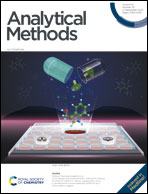A microplate spectrophotometric method for analysis of indole-3-carbinol in dietary supplements using p-dimethylaminocinnamaldehyde (DMACA) as a chromogenic reagent
Abstract
This work presents the development of a microplate spectrophotometric method for determination of indole-3-carbinol in dietary supplements. The colorimetric procedure is based on the reaction of indole-3-carbinol with the p-dimethylaminocinnamaldehyde (DMACA) reagent under acidic conditions. The absorbance of the colored product measured at 675 nm was used to determine the target analyte. To achieve optimal spectrophotometric performance, the DMACA reagent concentration, the hydrochloric acid concentration, and the reaction time were optimized. The developed technique performed well under the optimal conditions, with a linear calibration range of 30 to 300 mg L−1 and a high correlation coefficient (r2 = 0.9954). The limit of detection and limit of quantification were 7.8 mg L−1 and 26.2 mg L−1, respectively. This approach demonstrated good repeatability (intra- and inter-day precision) with a % RSD lower than 9.4%, good accuracy with acceptable relative recoveries in the range of 98 to 106%, and high sample throughput (24 detection per min). This simple, rapid, and multi-sample analysis approach for routine analysis of indole-3-carbinol has the potential to be used for the quality control of dietary supplements.



 Please wait while we load your content...
Please wait while we load your content...